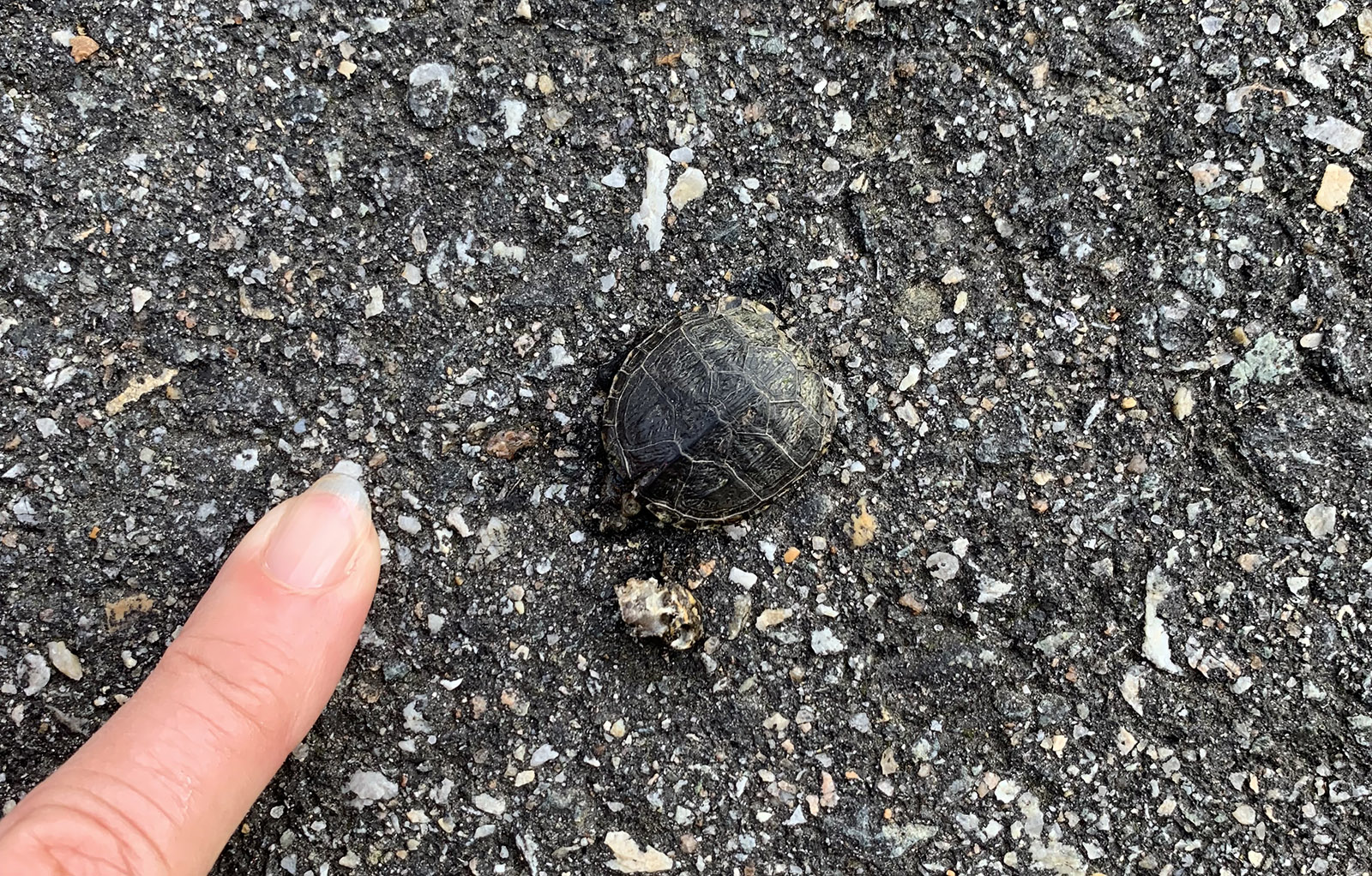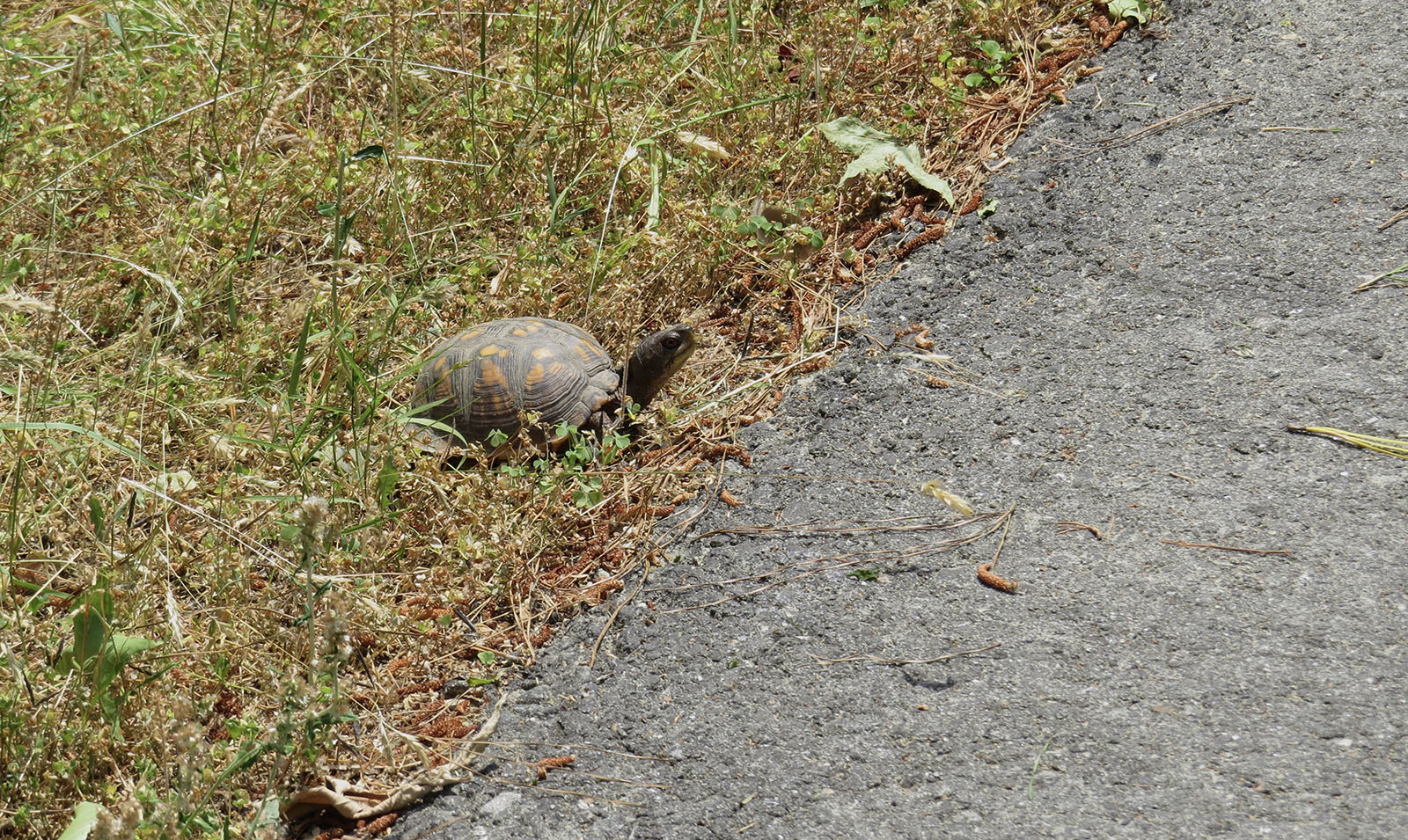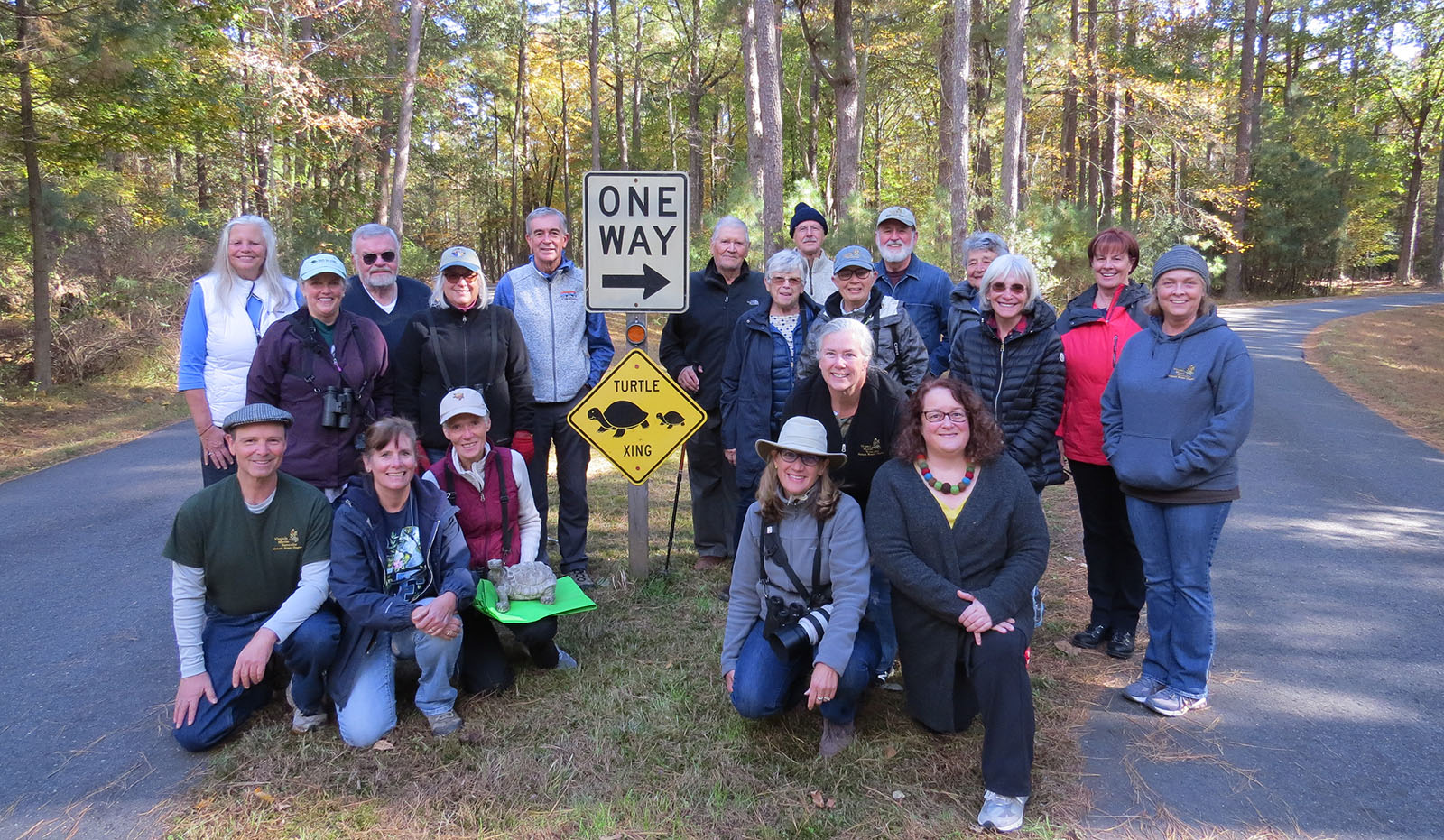By Andrea Naccarato/DWR
Photos by Nancy Barnhart
Imagine that you are a turtle. Shell on your back, scaly skin, pointy claws. You recently awoke from your winter slumber in some squishy mud along the edge of a pond. The spring sun warms your body enough so that you can venture to another, larger pond nearby. There might be more food there.
You’ve hauled yourself uphill from your winter pond to a dry, flat land, when suddenly the earth begins to rumble. A strong gust of wind rips by and you pull your head and legs back inside your shell. What was that? A giant animal running by?
No, it was a car. And the flat land was a road splitting the connection between the two ponds. The presence of a road in between two habitats (or cutting through a single habitat) poses a huge danger to turtles and other wildlife going about their daily or seasonal movements.
Biologists and community scientists study these landscape-level threats to wildlife conservation. One of those biologists is Meagan Thomas, working for the Virginia Department of Wildlife Resources (DWR).
According to Thomas, “Road mortality is a leading cause of turtle population declines and typically reaches a high point during breeding and nesting seasons when turtles are making larger movements in search of mates or places to lay their eggs. All this moving around puts them in regular contact with roads, where they risk being hit and killed by motor vehicles.”
This risk was recognized on Jamestown Island within Colonial National Historical Park a few years ago. At least five species of turtle move between two habitat types (uplands and wetlands) that are split by the Park’s Island Loop Drive, a paved route typically open to pedestrians, cyclists, and vehicles.
Virginia Master Naturalist Nancy Barnhart, who records wildlife observations for the Park, noticed an unsettling pattern in April 2021. “More and more visitors were reporting seeing dead turtles on the Loop Road,” she said.
After consulting with the Park’s Resource Ranger Dorothy Geyer, Barnhart conducted a quick turtle survey along Loop Drive. “I found around 13 little dead hatchlings. Even if you’re driving carefully, [they are] really hard to see,” said Barnhart.

Hatchling turtles crossing roads can be extremely difficult for drivers (or even pedestrians) to see.
Although the thought of hatchling turtles dying under car tires is disheartening, the impact to the population is especially serious when adult turtles are killed.
“Turtles are so slow to grow and hit reproductive maturity, and the survival rate of juveniles to adulthood is already pretty low to begin with,” said Thomas. “When a high number of breeding adults disappears, the population declines and localized extinction is likely to follow in future years.”
Everything is connected in nature. If a population of turtles were to disappear, that event would have a ripple effect. Other beings directly or indirectly linked to the turtles would be affected. So, what needed to be done to help the turtles on Jamestown Island?
With support from Geyer, Barnhart reached out to her fellow Master Naturalists to tackle a more intensive survey of Loop Drive. “I recruited volunteers, which was very easy, because everybody loves turtles. I had 30 volunteers in a heartbeat,” said Barnhart.
The Master Naturalists from the Historic Rivers Chapter committed to doing twice-daily surveys (morning and afternoon) from June through October of 2021. During each survey, the volunteers recorded the location of any road-killed turtles using GPS. They also noted the time of day, weather, and surrounding habitat types.
The turtle mortality data justified a seasonal closure of Loop Drive. Beginning in 2022, Loop Drive was closed to vehicles for the “final weeks of March and during the months of April, May, and June to allow turtles to move safely through their wetland habitat.” Visitors could still traverse the road on foot or bicycle.

The brown and orange colors on this turtle’s shell blend into the fallen pine needles at the road edge, making this turtle and others like it difficult for drivers to see. Colonial National Historical Park decided to keep vehicles off Jamestown Island Loop Drive to protect migrating turtles.
But the turtle-monitoring volunteers did not rest during the road closure. The timing of the closure specifically aligned with the peak in turtle activities, such as egg laying and hatching. Now was the time to find out if keeping vehicles off the road meant fewer dead turtles. The Master Naturalists did more surveys in May and June of 2022.
“We were able to observe far fewer victims of roadkill. Eliminating cars is definitely making a difference,” said Barnhart.
The difference was significant enough for the Park to continue with the seasonal road closure. Even though closing the road to vehicles changes the visitor experience to the Park, this is a positive change for people as well as turtles. This year’s closure begins March 18, and the end of the closure will be decided in June after monitoring turtle activity. According to a Park press release, “This year’s study will be the most comprehensive turtle activity study to date at Colonial National Historical Park. It will provide insight into turtle activity patterns and identify predictors of turtle activity allowing the park to take more effective management actions.” In addition, the Park will host “Turtle Tent” events where visitors can participate in a variety of educational hands-on activities designed to increase awareness about turtles, the dangers they face, and how to best protect them during hatchling season.
“One of the very cool things that came of this was the engagement of the regular users of the road,” said Barnhart. “We have a lot of community members that love [Loop Drive], who bike or run or walk or drive it on a regular basis. And because they saw us out there all the time, they became engaged [with the plight of the turtles].”
Another inspiring thing demonstrated by the Master Naturalists is that conservation of species can be achieved by anyone. “One of the things that I love so much about this story is how much it solidifies the fact that you don’t need to be a natural resources professional to create an impactful conservation change,” said Thomas.

Nancy Barnhart (shown in the front row holding a turtle statue) organized a team of Virginia Master Naturalist volunteers to complete five months of twice-daily surveys of Jamestown Island Loop Drive with an end goal to protect migrating turtles. Photo by Bill Williams
“In addition to directly preventing turtle mortality events, [the Master Naturalists] are also using this as an opportunity to educate all the curious people they encounter while sampling,” Thomas continued. “I certainly like to hope that at the very least their audiences are paying closer attention and looking for turtles crossing the road back home.”
So many of us drive on roads every day that bisect wildlife habitats. Adopting wildlife-aware driving practices can help keep you, other drivers, and wildlife safe:
- Do not exceed posted speed limits. Drive extra-cautiously at night and during adverse weather when wildlife may be less visible.
- Focus on driving and pay attention to any changes in your surroundings:
- Take special note of any wildlife crossing signs.
- Use your knowledge of any adjacent waterbodies or habitats and types of animals that may be nearby.
- Scan the pavement, medians, and road shoulders.
- Look for unexpected movement or an odd shape that could be an animal.
- Slow down if you think an animal could be near the road ahead.
And what do you do if you see a turtle poised to cross the road?
Here are some “Tips for Moving Turtles Safely” from Virginia Wildlife’s March/April 2024 issue:
- Make sure you’re helping safely. Pull off to the side of the road in such a way that doesn’t impede traffic or jeopardize your safety or the safety of others. Keep an eye out for oncoming traffic.
- Use care when moving the animal. If you can, it’s best to simply stop traffic to allow the animal to cross on its own. Don’t pick up the turtle by the tail.
- Don’t divert the turtle. If you determine the animal needs help crossing, move it to the side of the road where it was headed.”
To sum it up, Thomas suggests: “Treat a turtle the same way you would treat your great-grandmother when she is crossing the road.”
You’d assist your great-grandmother by gently guiding her in the direction she was going and making sure she completed the journey safely. Do the same with turtles! Don’t disorient the turtle by turning it around. Instead, gently help it to the other side of the road. Likewise, don’t kidnap it and keep it as a pet or drive it to a distant neighborhood and drop it off.
Related Resources:
- Colonial National Historical Park
- DWR Wildlife Information
- Purchase DWR’s Guide to the Turtles of Virginia
- U.S. Fish and Wildlife Service’s Tips for Helping a Turtle Cross the Road
Andrea Naccarato is the DWR outreach production assistant. Before moving to Virginia, she spent three summers monitoring sea turtles nesting on southwest Florida’s barrier islands.


